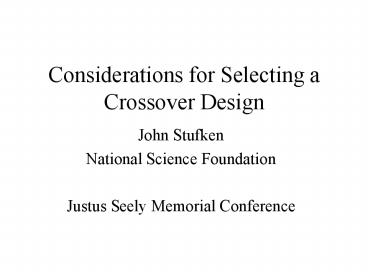Considerations for Selecting a Crossover Design
1 / 14
Title:
Considerations for Selecting a Crossover Design
Description:
ABBA, ABAB (79, 73) 95. AABB, ABAB (68, 87) 97. AABB, ABBA (58, 100) ... ABBA (100, 46) 97. ABAB. Model 4. ? = (-1/3, 1/3) Model 3. Design (p=4, t=2) In Summary ... –
Number of Views:140
Avg rating:3.0/5.0
Title: Considerations for Selecting a Crossover Design
1
Considerations for Selecting a Crossover Design
- John Stufken
- National Science Foundation
- Justus Seely Memorial Conference
2
Considerations for Selecting a Crossover Design
- John Stufken
- University of Georgia
- Justus Seely Memorial Conference
3
How to Survive at the NSF ?
- Kunert and Stufken, 2002, JASA
- Hedayat and Stufken, 2003, JBS
- Bose and Stufken, 2003, in preparation
- Presentation will draw from all three of these
4
What is a Crossover Design Notation
- t treatments n subjects p periods design is a
p by n array - A crossover design for t4, p3,
n12 A C B D A B A D C D B C B A C B D A C A
D C D B C B A A B D D C A B C D - Yij random variable for the observation in
period i for subject j assumed to be continuous. - d(i,j) the treatment assigned to subject j for
period i by design d (after randomization)
5
What is a Crossover Design Notation
- t treatments n subjects p periods design is a
p by n array - A crossover design for t4, p3,
n12 A C B D A B A D C D B C B A C B D A C A
D C D B C B A A B D D C A B C D - Yij random variable for the observation in
period i for subject j assumed to be continuous. - d(i,j) the treatment assigned to subject j for
period i by design d (after randomization)d(2,3)
C
6
Why Use a Crossover Design?
- Practical considerations a crossover design
requires fewer subjects for the same number of
observations than a parallel trial - Increased precision of treatment comparisons due
to the availability of within-subject information - But ...
7
- Possible Concerns When Using a Crossover Design
- The duration of the experiment tends to be longer
than with a parallel trial typically only a
small number of periods is used - Possibility of dropouts missing data
- Carry-over effects (wash-out periods modeling of
carry-over effects) treatment-period interaction - Within-subject covariance structure
8
Simple Models When Using a Crossover Design
- Assumes a continuous dependent variable fixed
effects - Yij µ pi ßj td(i,j) eij no carry-over
effects model - Yij µ pi ßj td(i,j) ?d(i-1,j) eij
traditional model - Yij µ pi ßj td(i,j) (1-dij) ?d(i-1,j)
dij fd(i-1,j) eij self and mixed carry-over
effects model - Yij µ pi ßj td(i,j) ?td(i-1,j) eij
proportional carry-over effects model
9
- Optimal Designs
- Just one of the considerations that should play a
role when selecting a crossover design - Will focus on the models just shown, with all
effects fixed, and error terms iid normal - Results shown will focus on two treatments (t2),
except for model 4 - Universal optimality criterion design is a
discrete probability measure over the possible
sequences - When t2, a sequence and its dual are used
equally often (e.g., the dual of ABB is BAA)
10
Optimal designs under model 4
- For a fixed ?, a design d is universally optimal
for treatment effects if - d is uniform over the periods
- Cd11, Cd12 Cd21 and Cd22 are completely
symmetric matrices and - d uses only sequences that are admissible for
this ? - Only iii. depends on ? and needs additional work.
It is completely solved for p2,3,4 in Bose and
Stufken, 2003
11
- Example 1 p 2, t 2
- For any ? ? 2, only AB is admissible
- t2 AB, BA t3 AB, BC, CA t4 AB, AC, AD,
BA, BC, BD, CA, CB, CD, DA, DB, DC - Example 2 p 3, t 2
- If ? 0, only ABB is admissible ABB, BAA is
optimal - If ? optimal
- Example 3 p 3, t 3
- ABC ABA ABC
ABB ABC - -4.73 -1.27
0.52 11.48 - ?
12
(No Transcript)
13
(No Transcript)
14
- In Summary
- There are many considerations for deciding
whether to use a crossover design and, if so,
which one to use - Optimal design considerations are but one of
these - Different models can lead to vastly different
optimal designs - It may be prudent to select a design that is
efficient under a variety of possible models - Mathematical tools are now available to compute
such efficiencies under many different models































